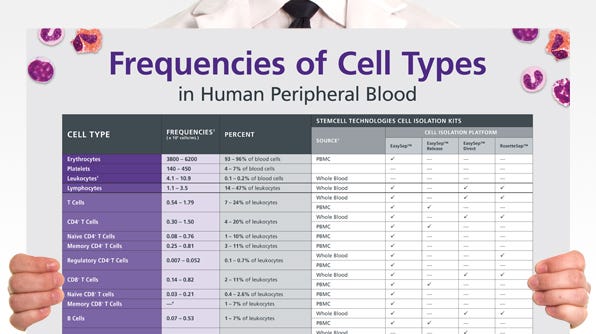Inflammatory and Autoimmune Diseases
Inflammatory and autoimmune diseases are often caused by genetic and environmental factors that give rise to aberrant immune responses. Controlling host immune responses without eliminating the ability to control infections is crucial to managing these diseases.
Below is a collection of scientific resources for your inflammatory and autoimmune disease research.
Frequencies of Cell Types in Human Peripheral Blood
This wallchart provides a list of the frequencies of cell types in human peripheral blood, as well as the column-free cell isolation kits available for each cell type.
Get Your Free Copy >-
 Modeling Alzheimer's risk using human TREM2-knockout microgliaAmanda McQuade from Dr. Mathew Blurton-JonesÔÇÖs lab discusses her protocol for differentiating microglia from induced pluripotent stem cells (iPSCs) and the use of these microglia in vivo and in vitro to uncover the mechanisms of immune activation and neurodegeneration in AlzheimerÔÇÖs disease.
Modeling Alzheimer's risk using human TREM2-knockout microgliaAmanda McQuade from Dr. Mathew Blurton-JonesÔÇÖs lab discusses her protocol for differentiating microglia from induced pluripotent stem cells (iPSCs) and the use of these microglia in vivo and in vitro to uncover the mechanisms of immune activation and neurodegeneration in AlzheimerÔÇÖs disease. -
 Reducing Platelet Contamination in Blood SamplesPlatelets (thrombocytes), cell fragments derived from megakaryocytes, are used in normal blood clotting, and must be handled gently to prevent activation
Reducing Platelet Contamination in Blood SamplesPlatelets (thrombocytes), cell fragments derived from megakaryocytes, are used in normal blood clotting, and must be handled gently to prevent activation -
 Isolate Virtually Any Cell Type Using EasySepÔäó or EasySepÔäó Release Indirect Selection KitsUse any biotinylated, FITC-, PE- or APC-conjugated antibody to label your desired cells and mix with EasySepÔäó reagents to obtain highly purified cells
Isolate Virtually Any Cell Type Using EasySepÔäó or EasySepÔäó Release Indirect Selection KitsUse any biotinylated, FITC-, PE- or APC-conjugated antibody to label your desired cells and mix with EasySepÔäó reagents to obtain highly purified cells -
 Considerations for Flow Cytometry GatingTo achieve accurate results, it is important to use an optimal gating strategy when assessing cell samples via flow cytometry
Considerations for Flow Cytometry GatingTo achieve accurate results, it is important to use an optimal gating strategy when assessing cell samples via flow cytometry -
 Total Nucleated Cell and Viable Cell CountsAccurate cell counts are important in experiments. Ideally both the total nucleated cell (TNC) count and the viability of the cells should be assessed
Total Nucleated Cell and Viable Cell CountsAccurate cell counts are important in experiments. Ideally both the total nucleated cell (TNC) count and the viability of the cells should be assessed -
 Immunology Profiles - Kyle BurrowsKyle Burrows discusses his research on mucosal immune regulation and innate lymphoid cells, and his cell isolation platform of choice, EasySepÔäó
Immunology Profiles - Kyle BurrowsKyle Burrows discusses his research on mucosal immune regulation and innate lymphoid cells, and his cell isolation platform of choice, EasySepÔäó -
 Assessment of Your Starting Sample and Calculation of Recovery from Cell Isolation ProceduresSetting aside a small portion of your starting sample allows you to assess the frequency of desired cells in the sample prior to isolation
Assessment of Your Starting Sample and Calculation of Recovery from Cell Isolation ProceduresSetting aside a small portion of your starting sample allows you to assess the frequency of desired cells in the sample prior to isolation -
 Regulatory T CellsOverview of the development, phenotype and functions of regulatory T cells
Regulatory T CellsOverview of the development, phenotype and functions of regulatory T cells -
 Kyle Burrows, BScKyle Burrows describes his work in the Zaph lab examining the molecular mechanisms that regulate CD4 + T cell subsets and innate lymphoid cells
Kyle Burrows, BScKyle Burrows describes his work in the Zaph lab examining the molecular mechanisms that regulate CD4 + T cell subsets and innate lymphoid cells -
 Thomas Krausgruber, PhDDr. Thomas Krausgruber discusses his research on understanding the complex relationship between our immune system and the intestinal microenvironment
Thomas Krausgruber, PhDDr. Thomas Krausgruber discusses his research on understanding the complex relationship between our immune system and the intestinal microenvironment



